Marina Mnishek. Trying to be Theodora
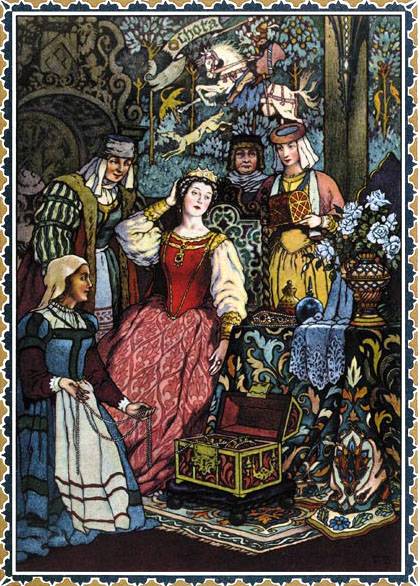
Marina Mnishek in the painting by B. Zvorykin
В previous article we talked about the life of Marina Mnishek before the assassination of False Dmitry I. Her reign in Moscow lasted only 9 days, she miraculously escaped violence, or even death, and now two paths were open to her. She was about 18 years old, she could return to her homeland, get married again and live a long life as an ordinary “noble lady.”
And, since she had gone through the coronation procedure, she had the right to continue to call herself the Moscow Tsarina - albeit a dowager. But Marina decided to fight for the Moscow throne, ultimately destroying herself and her son, as well as many people who considered her the rightful queen. In Mussorgsky's opera Boris Godunov, Marina Mnishek says:
And noble lords
It won't relieve hellish boredom...
Panne Mniszech is too boring
A languid outpouring of passion,
Ardent youths praying,
Vulgar speeches of tycoons.
Panna Mniszech wants fame
Panna Mniszech thirsts for power!
To the throne of the kings of Moscow
I will sit as queen
And in gold-woven purple
I'm shining with the sun.
And I will slay you with wonderful beauty
I am the stupid Muscovites,
And herds of arrogant boyars
I'll force you to hit me with your forehead.
And they will be glorified in fairy tales,
Tales, fables
I'm proud of my queen
Stupid boyars!
Marina Tsvetaeva wrote about her:
Mishka the arrogant daughter...
Damn you, damn you
You are the False Dmitry who could be the False Marina!”
We will talk about this in today's article.
False Dmitry II
So, already on May 19 (29), 1606, a new tsar, Vasily Shuisky, was “called out” (elected) in Moscow. His coronation took place on June 1 (11) of the same year.
On June 9, Jerzy Mniszek appeared before the boyars, who had recently solemnly welcomed “Tsarevich Dmitry”, and now hypocritically accused him of bringing a “traitor and impostor” to Moscow. In August 1606, he, his daughter Marina and 375 retinue, who were allowed to take with them weapon, were sent to Yaroslavl. Here they were treated quite kindly and they did not experience any oppression then.
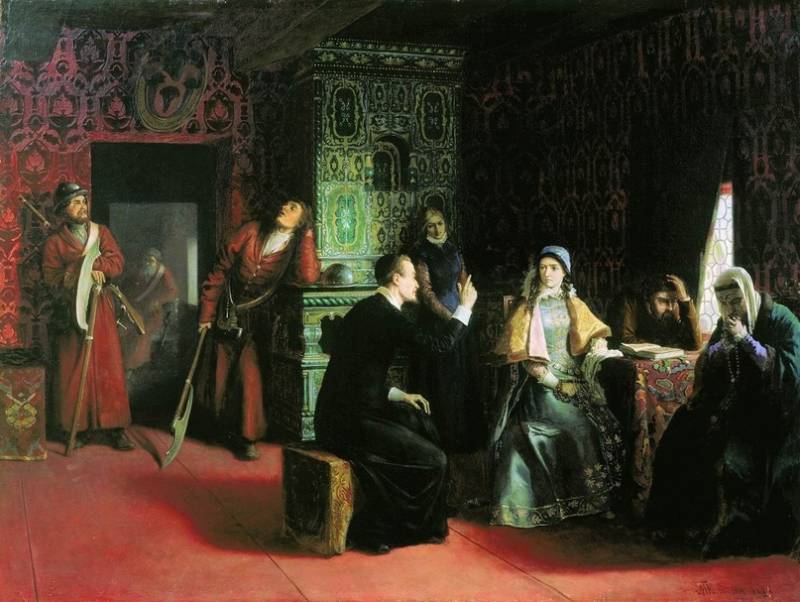
M. P. Klodt. Marina Mnishek with her father in custody in Yaroslavl
But, as we remember, the killers of False Dmitry “overdid it”, mocking his corpse - so that many later did not recognize the body of the former tsar. In addition, the mother of the real Dmitry, who they tried to force once again to “identify her son,” uttered a mysterious and very cynical phrase:
That is, on the one hand, she called the murdered man an impostor, but, on the other hand, she gave reason to believe that her “son” was “saved” again.
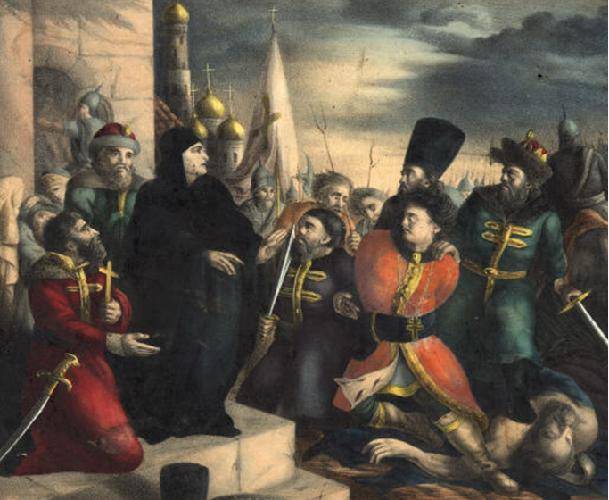
“Queen Martha denounces False Dmitry.” Colored lithograph based on a sketch by V. Babushkin
And one of the close associates of False Dmitry I (and the murderers of Fyodor Godunov) is Mikhail Molchanov, whom the Dutch merchant, traveler and diplomat Isaac Massa called “a great rogue and flatterer, who feared neither God nor people” and “a secret accomplice (of the Impostor) in all cruelties and debauchery,” fled to Poland. On the way, he told everyone about the salvation of the king.
Many people believed him - even Mnishek’s father and daughter, who also heard these rumors. At first, Molchanov, who reached Sambir, tried to declare himself the saved tsar and was recognized as such by Ivan Bolotnikov - the fugitive appointed him commander of the army. But Molchanov was not like the False Dmitry that many saw.
Prince G.K. Volkonsky, ambassador to the Polish-Lithuanian Commonwealth, gives the following description of the appearance of the “Sambir thief”:
The Polish man can speak Polish and read and write, and he can speak Latin.”
Having completed his career as an impostor, Molchanov returned to Moscow in 1608, was captured as a participant in a conspiracy against Shuisky and whipped. In 1609, he ended up in the detachment of the Polish hetman Sapega, then in the Tushinsky camp of False Dmitry II and became a guard under him. Then he was among the boyars who offered the crown of the Moscow state to the Polish prince Vladislav. During the Polish occupation of Moscow, he served as manager of the Pansky Prikaz and was cursed by Patriarch Hermogenes. In 1611, he was killed by rebel Muscovites.
So, there was no new False Dmitry from Molchanov, but we didn’t have to wait long for other impostors. Already at the beginning of 1607, in Vitebsk there was a man somewhat similar to the first Pretender, who on January 8 (18) presented a manifesto to Vasily Shuisky. True, very soon he himself became frightened of his courage and fled to Propoisk, where he ended up in prison. It is believed that there the Poles and their Russian allies “made him an offer that cannot be refused”: torture or even death, or continue to play the role of the saved Dmitry.
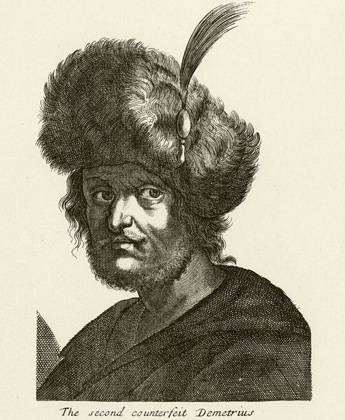
Portrait of False Dmitry II. Engraving. XNUMXth century
Konrad Bussov conveys the following words of Hetman Jan Sapieha, spoken by him near the Trinity-Sergius Monastery:
And S. Platonov wrote about it this way:
But the Polish king Sigismund III did not want war with Russia at that time, and therefore in May the new impostor went to Russia under the name of Andrei Nagogo to spread rumors about the “miraculous salvation of Tsar Dmitry.”
However, everything did not go according to plan: in Starodub, local residents and the Putivl delegates who arrived there began, under threat of torture, to demand to know the place where the surviving king was hiding. The impostor had to improvise: he accused the crowd of “unwillingness to recognize the true Sovereign,” his companions confirmed that the False Nag was Demetrius - and soon many southern cities swore allegiance to him.
So, who was this impostor, who could read and write in Russian and Polish (and some claim that he also knew Hebrew), and was well versed in church rituals? Prince Dmitry Mosalsky Gorbaty, governor of False Dmitry II, testified under torture that the impostor was “from Moscow from the Arbatu from Zakonyushev priests’ son Mitka.”
Boyar son Afanasy Tsyplatev, who served the second False Dmitry, stated that “Tsarevich Dmitry is called Litvin, Ondrei Kurbsky’s son.”
The cellarer of the Trinity-Sergius Monastery Abraham (Averky Palitsyn) considered him to come from a family of Starodub children of the boyar Verevkins.
The Jesuits considered the impostor to be a baptized Jew Bogdanko, who had previously been a teacher in Shklov, and then served in one of the churches of Mogilev, where his resemblance to the first impostor was noticed by the Pole M. Mekhovsky, who knew False Dmitry I.
Some considered him to be the Lithuanian clerk Bogdan Sutupov, or one of the clerks of False Dmitry I. And the ambassadors of the second False Dmitry once stated during negotiations:
It was this man who was destined to enter history, like the Tushinsky thief and False Dmitry II. He did not have time to help Ivan Bolotnikov, who was defeated in besieged Tula, but in the spring of 1608, his army, led by the Lithuanian hetman Roman Ruzhinsky, defeated the government troops of Dmitry Shuisky (the tsar’s brother) at Belev and in June encamped in the village of Tushino.
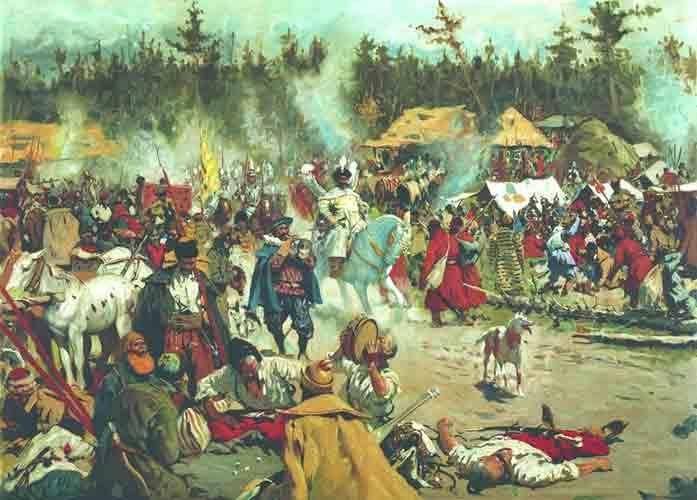
False Dmitry II and the Tushino camp in the painting by S. V. Ivanov, 1908
Tushinsky thief's wife
In Tushino, False Dmitry II had his own boyar duma and his own patriarch - Filaret (Romanov), who until the end of his life the people would call him “the thieves”. He was the father of the future Tsar Michael, and received the rank of metropolitan from the first Pretender. And then both Filaret and Mikhail swore allegiance to the Polish prince Vladislav, who renounced the crown of the Muscovite kingdom only under the terms of the Polyanovsky Peace - in 1634: Mikhail Fedorovich Romanov bought this title from him for 20 thousand silver rubles.
But let's return to Marina Mniszek. On July 13 (23), 1608, the new Tsar Vasily Shuisky concluded a peace treaty with the Polish king Sigismund III, and one of its points was the release of all captive Poles (including Mnishkov) to their homeland. They tried to force Marina to renounce her rights to the Russian throne, but the proud Pole declared that she was crowned king and therefore was the legitimate ruler of the country. Apparently, they decided to get rid of her, and in mid-August 1608, she and her father were released to Poland.
However, old Mnishek contacted False Dmitry II (unlike his daughter, he had no illusions about the miraculous salvation of the first impostor), who was then in Tushino, and offered to recognize him as his son-in-law. The price was 30 thousand rubles (and after the occupation of Moscow, the Pretender promised another 300 thousand zlotys), the Seversk principality with 14 cities and part of the Smolensk land. By the way, on January 17, 1609, Jerzy Mniszek left for Poland and over time practically stopped contacts with the daughter he abandoned.
The Tushino detachment, led by captains Zborovsky and Stadnitsky, intercepted the Mnishek family on the way.
It was then that Marina learned that she was being taken not to her real husband, but to an impostor who had adopted his name. A priest found in the Tushino camp secretly married Marina and the impostor: without this ceremony, she refused to perform marital duties. So pride and ambition pushed her into the arms of a man about whom the Polish captain Samuel Maskiewicz wrote:
Maximilian Voloshin wrote about this:
And she hugged me alive,
And, having gathered an unheard of army,
I approached Moscow again with glory.”
Marina and False Dmitry II in Kaluga
But soon the situation changed. Vasily Shuisky's appeal to Sweden, which was then at war with the Polish-Lithuanian Commonwealth, for help led to Sigismund III declaring war on the Muscovite kingdom and besieging Smolensk in September. The Tushino camp was disintegrating: the Poles and some of the Russians went over to serve Sigismund, the rest were on the verge of rebellion.
And therefore, on December 27, 1609 (January 6, 1610), False Dmitry II chose to flee from Tushino to Kaluga - in a simple cart, hiding under shingles. Historians believe that it was from this time that False Dmitry II became an independent figure - until then he was just a puppet in the hands of others and he himself understood this.
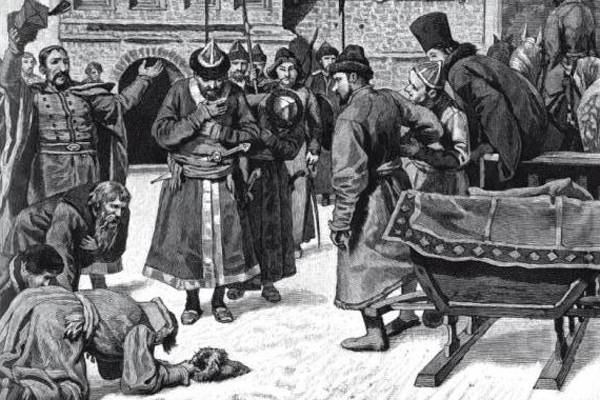
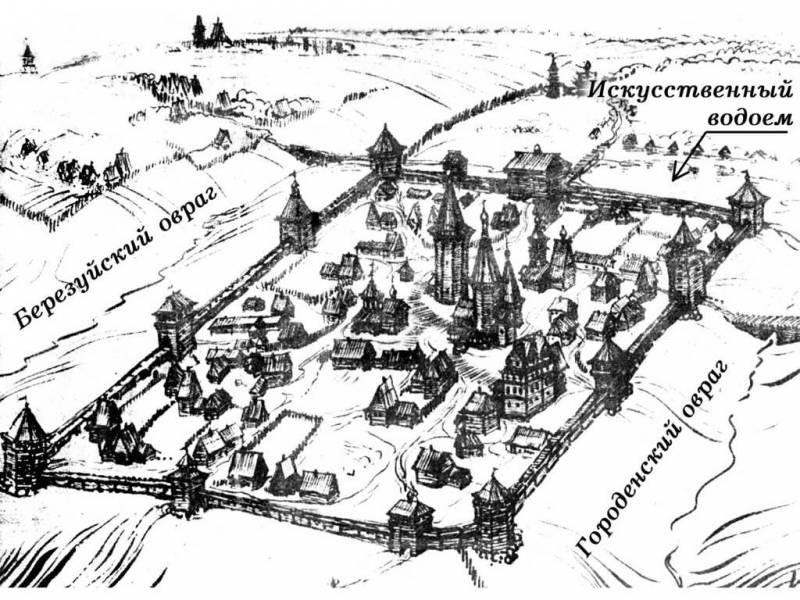
And the “thieves” Tushino Patriarch Filaret and the boyars of the local Duma on February 4 (14), 1610, concluded an agreement with Sigismund III, according to which the king’s son, Vladislav, was to become the new Russian Tsar. On the night of February 24, Marina Mnishek also fled from Tushino, dressed in a man’s suit, to Kaluga. She left a note in her tent:
Heading south, to Kaluga, she ended up north - to Dmitrov. Either she didn’t know the way, or she purposefully went there, since this city was occupied by the troops of an ally, Jan Sapieha. She also told him:
Having withstood a short siege in Dmitrov, Marina finally reached Kaluga.
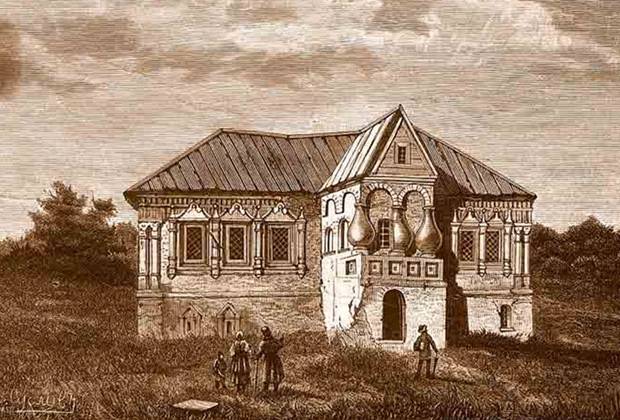
Kaluga, the supposed house where False Dmitry II and Marina Mnishek lived. Engraving by M. Rashevsky based on fig. I. Suslova. 1884
A new campaign against Moscow
After the unexpected death of the young governor M.V. Skopin-Shuisky, who managed to lift the siege of the Trinity-Sergius Lavra (according to rumors, he was poisoned by the wife of the Tsar’s brother Dmitry), on June 24, 1610, the Tsar’s army near Kluschin was defeated by the Polish army of Crown Hetman Stanislav Zhulkevsky. The deposition of Vasily Shuisky by the Moscow boyars led by Zakhar Lyapunov on July 17 (27), 1610 completely confused the situation.
Having assembled a new army, False Dmitry II took Serpukhov, Borovsk, Pafnutiev Monastery and on August 2 (12) besieged Moscow - this time he settled in the village of Kolomenskoye. Fearing the capture of the capital by False Dmitry, the new Moscow government (the notorious Seven Boyars) on August 17 (27), 1610, decided to swear allegiance to Prince Vladislav. Muscovites opened the gates to the Polish troops of Zhulkevsky. He, on behalf of the king, promised False Dmitry and Marina a choice of Sambir or Grodno. However, Marina, as the hetman wrote in his memoirs, replied:
Did she believe in success? Or was the very thought of returning to the life of an ordinary lady really unbearable for her? Perhaps she was inspired by the fiery speech delivered by the Byzantine Empress Theodora during the Nika uprising:
Death of the second Imposter
But the forces were no longer equal, and the Pretender again retreated to Kaluga, where he began to organize the executions of captured Poles, who were brought by the Don ataman Ivan Zarutsky and the Tatar (Nogai) prince Araslan (baptized Peter) Urusov. Subsequently, False Dmitry II planned to leave for Voronezh, but on November 22 of the same 1610, he, believing the denunciation, ordered the execution of his ally, the Kasimov Khan Uraz-Muhammad. The already mentioned Pyotr Urusov avenged his relative: on December 11 (21), the impostor was killed while hunting.
Look at the photographs of the Kaluga Forest, where the murder of False Dmitry II took place:


In the Chronicle of Khanykov you can read that Pyotr Urusov shot False Dmitry with a pistol, then, with the words: “I will teach you how to drown the khans and put the Murzas in prison,” he cut off his head. After this, he fled to Astrakhan, where he found and supported a new impostor, who went down in history as False Dmitry IV. He then ended up in Crimea, where he was eventually executed in 1639 by order of Khan Bahadir I Giray.
The pregnant Marina Mnishek became hysterical, she tore her clothes and hair and, calling for vengeance, ran with her breasts bare, demanding to kill her too. The Don Cossacks of Ataman Ivan Zarutsky, avenging the death of the “sovereign,” began to beat up the innocent “best” Tatar Murzas (the impostor’s killer, as we remember, had already fled to Astrakhan).
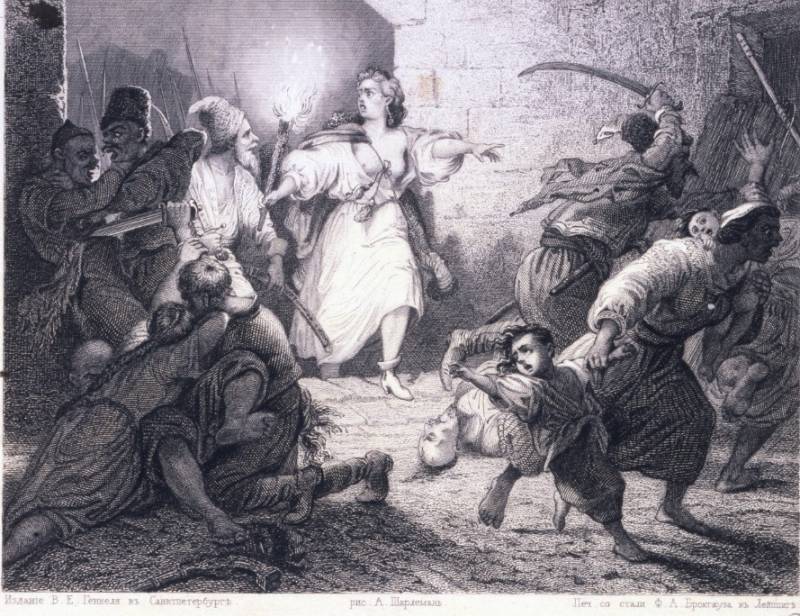
Marina Mnishek, inciting Kaluga residents to revenge for the death of the Tushino thief (from a drawing by A. Charlemagne)
Let us turn again to the poem by M. Voloshin, written on behalf of the Pretender:
In the city of Kaluga above the Oka,
Killed by the Tatars and Zhmud...
And Marina with her breasts naked,
Raising torches above your head,
Prowled over the frozen river
And, circling around Moscow, in anger
Raised new dead
And she carried me alive in her womb.”
Just a few days later, Marina gave birth to a son, who was named Ivan. The residents of Kaluga and the army of False Dmitry II, including the Cossacks of Ivan Zarutsky, took the oath to the “prince.” Now Marina Mnishek has placed her bet on a newborn boy, hoping that he will become the new Russian Tsar. According to some reports, in addition to Zarutsky, the leader of the Ryazan militia, Prokopiy Lyapunov, was ready to recognize his rights to the throne.
In the next article we will continue and finish the story about Marina Mnishek.
Information